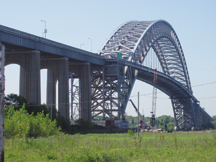No, space aliens aren’t threatening to destroy the Bayonne Bridge, as was depicted in the 2005 film “War of the Worlds.” But the bridge has become a target of concern as ships carrying cargo bound for Port Elizabeth and Port Newark may soon find it impossible to travel under it.
Completed in 1931, the same year as the George Washington Bridge and the Empire State Building, the 325-foot tall Bayonne Bridge provides a critical link between the southern most tip of Hudson County to Staten Island, and more than eight million cars pass over it annually.
Yet as important as this is, the traffic traveling under the Bayonne Bridge is even more important. The Kill Van Kull, over which the bridge stretches, is the sole entrance to the complex of ports along the Western shore of Newark Bay.
“If the Bayonne Bridge is not raised, larger ships will not be able to use our port, seriously limiting economic growth in New York harbor.” — Rep. Michael E. McMahon
________
The Port Authority just released the results of a study completed by the U.S. Army Corps of Engineers, which found the Bayonne Bridge’s height will pose a serious obstacle for the New York-New Jersey Port to handle the newest and largest commercial ships in the coming decades.
With the scheduled expansion of the Panama Canal set to be completed in 2014, the number of large commercial shipping vessels is set to grow significantly in the region; however, the current height of the bridge will make it impossible for these ships to access the port. The report examined several potential solutions, including a tunnel linking Bayonne and Staten Island or increasing the bridge height to 215 feet by either raising the bridge or constructing a new bridge.
“This issue needs to be addressed now,” said McMahon. “If the Bayonne Bridge is not raised, larger ships will not be able to use our port, seriously limiting economic growth in New York harbor. We need to find a solution to this problem, which also focuses on increasing mass transit connections between Staten Island and Bayonne, and extends the light rail line. Our port is one of the most active in the country and is critical to the future of good quality jobs in my district. If we do not immediately start addressing the Bayonne Bridge height limitation, our local economy will undoubtedly suffer.”
The Army Corps’ report also recommended further planning and environmental analyses to determine a preferred project alternative. The Port Authority authorized $10 million last month to begin this phase of the project. The study should be completed in 2010.
“More than 269,990 jobs are generated by activity in the Port of New York and New Jersey,” said Sires. “We must act now to secure these jobs and maintain the port’s status as one of the largest and most productive port complexes in the nation. This report combined with the Port Authority’s recent announcement to advance an alternative study is critical to moving the project forward and keeping the port competitive. As a member of the Transportation and Infrastructure Committee, I will continue to advocate for a solution to the Bayonne Bridge height restriction.”
Buddy Smith, a longshoreman who has spent the last 29 years working throughout the Newark Bay complex, during a recent tour of the harbor said the shipping industry may be the most important industry in the Metropolitan area.
“We are the largest – maybe the only – growing industry in the Northeast,” Smith said, looking out at new cranes that have been installed near the Newark-Elizabeth border on Newark Bay, which have been designed to handle freight from the new fleets of cargo ships that dwarf in size against many of the existing ships.
Unfortunately, Smith noted, these new ships cannot sail under the Bayonne Bridge, and though the Army Corps of Engineers is dredging the Kill van Kull, the bridge still poses an obstacle – a matter that may see the reconstruction of the bridge in the near future. Many of the 5,000 ships that pass under the bridge every year find the bridge too low, delaying entry for the lowest tide so as to increase the clearance.
Bayonne Bridge has a clearance at most of 151 feet high. Most new super-sized ships when compacted are 145 feet high, too close to calculate for safe passage. Port officials believe the bridge will either need to be elevated or replaced with a high bridge so that the estimated increase to 10,000 ships per year can be accomplished.
According to Joseph Doria, when he still served as mayor, the bridge has become a symbol of the city itself. Once known as a leading industrial city, the steel design of the bridge has come to symbolize the industrial strength of Bayonne.
